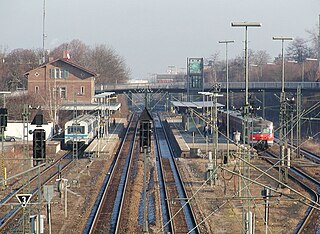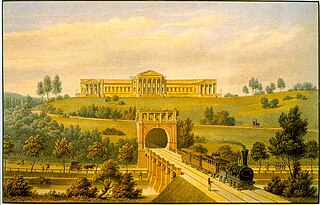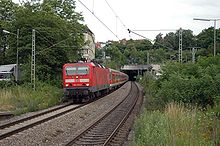
The Stuttgart S-Bahn is a suburban railway system (S-Bahn) serving the Stuttgart Region, an urban agglomeration of around 2.7 million people, consisting of the city of Stuttgart and the adjacent districts of Esslingen, Böblingen, Ludwigsburg and Rems-Murr-Kreis.

Stuttgart Hauptbahnhof is the primary railway station in the city of Stuttgart, the state capital of Baden-Württemberg, in southwestern Germany. It is the largest regional and long-distance railway station in Stuttgart, the main node of the Stuttgart S-Bahn network, and, together with the station at Charlottenplatz, it is the main node of the Stuttgart Stadtbahn.

The Stuttgart Stadtbahn is a light rail system in Stuttgart, Germany. The Stadtbahn began service on 28 September 1985. It is operated by the Stuttgarter Straßenbahnen AG (SSB), which also operates the bus systems in that city. The Stuttgart Stadtbahn is successor system of a tram network (Straßenbahnen) that characterized the urban traffic in Stuttgart for decades.

The name Verbindungsbahn is used in Stuttgart to describe the underground connecting line between the subterranean S-Bahn Stuttgart station at Stuttgart Hauptbahnhof and the tunnel exit at the station in Stuttgart-Österfeld, which connects, via tunnel, the Stuttgart valley and the Filder plateau. The term originates from the planning stages in the 1960s, when similar projects for the S-Bahn München and S-Bahn Rhein-Main were given the same term.

The Franconia Railway is a 180-kilometre-long (110 mi) railway line in the north of the German state of Baden-Württemberg and the Bavarian province of Lower Franconia that links Stuttgart and Würzburg. Its name comes from the fact that the majority of the line runs through Franconia. The first section of the line was opened in 1848 and is one of the oldest lines in Germany. The main line is now electrified and has been almost entirely upgraded to double-tracks.

Bietigheim-Bissingen station is a junction station in the town of Bietigheim-Bissingen in the German state of Baden-Württemberg where the Württemberg Western Railway separates from the Franconia Railway. With its eight station tracks it is the largest station in the district of Ludwigsburg. It is served by regional trains, line S 5 of the Stuttgart S-Bahn and line S 5 of the Karlsruhe Stadtbahn.

Ludwigsburg station is in Ludwigsburg in the German state of Baden-Württemberg on the Franconia Railway and the Backnang–Bietigheim line. It is served by regional trains and the Stuttgart S-Bahn. Until 2005 the Ludwigsburg–Markgröningen line also connected to the station. In addition, it has a direct link with Stuttgart's main marshalling yard at Kornwestheim.

The Karlsruhe–Mühlacker railway is a railway line in the west of the German state of Baden-Württemberg. It was built between 1859 and 1863 and is one of the oldest railways in Germany. It was built as the second connection between the networks of the Grand Duchy of Baden State Railway and the Royal Württemberg State Railways and it still constitutes an important east–west route in southern Germany.

Zuffenhausen station is a railway station of the Stuttgart S-Bahn in Zuffenhausen in the city of Stuttgart, in the German state of Baden-Württemberg. With its six platform tracks, it is one of the largest stations in Stuttgart.

Tübingen Hauptbahnhof is the largest station in the university town of Tübingen and the district of Tübingen, and a transport hub in the German state of Baden-Württemberg.

Bad Cannstatt station is the second largest station of the German city of Stuttgart after Stuttgart Hauptbahnhof and has eight platform tracks. Together with Untertürkheim station, it is the oldest station in Württemberg.

Schwabstraße station is a railway station in Stuttgart, Germany. It is located west of the city centre in Stuttgart-West district, along Rotebühlstraße at the intersection with Schwabstraße. The station originally formed the terminus of the first section of the Connection line, the original underground section of the Stuttgart S-Bahn. Several lines of the S-Bahn terminate at the station. It is notable for a 1.5 km long loop at the end of the station to allow S-Bahn trains to turn around.
The Backnang–Ludwigsburg railway is a line on the northern edge of the Stuttgart region in the German state of Baden-Württemberg, linking Backnang and Ludwigsburg. The Backnang–Bietigheim line was opened in 1879 as a branch of the Murr Valley Railway from Waiblingen to Hessenthal and left the current route at Beihingen-Heutingsheim. The section between Beihingen-Heutingsheim and Bietigheim was damaged during the Second World War and was never returned to operation.

Korntal station is in the town of Korntal-Münchingen in the German state of Baden-Württemberg. It is on the Württemberg Black Forest railway, which is served by the Stuttgart S-Bahn network. It is the starting point of the Strohgäu Railway, which is served by the Württembergische Eisenbahn-Gesellschaft.

Feuerbach station is an S-Bahn station in the Stuttgart borough of Feuerbach in the German state of Baden-Württemberg. It is on the Franconia Railway. The station is classified by Deutsche Bahn as a category 4 station and is classified as a haltepunkt (halt) because it now has no operable sets of points.

Stuttgart North station is a railway station in Stuttgart, Germany, serving the North area of the city. It consists of a passenger railway station on the Stuttgart S-Bahn and a goods yard.

Kornwestheim station is located in the Ludwigsburg district of Kornwestheim in the German state of Baden-Württemberg. It is located on the Franconia Railway and is a station on the network of the Stuttgart S-Bahn. It is near the junction of the Untertürkheim–Kornwestheim line (Schusterbahn) freight bypass. Kornwestheim passenger station was the site of a Deutsche Bahn car train loading facility until December 2007.

The Stuttgart-Untertürkheim–Kornwestheim railway is an 11.5-kilometre-long freight bypass in the German state of Baden-Württemberg. The double-track electrified main line connects Untertürkheim with Kornwestheim and serves primarily as a bypass for freight around Stuttgart Central Station (Hauptbahnhof). In the Deutsche Bahn timetable as route 790.11.

The Central Railway was the first phase of the Württemberg railways. It was built between 1844 and 1846 by the Royal Württemberg State Railways and consisted of two branches, running from Stuttgart to Ludwigsburg in the north and from Stuttgart to Esslingen in the east.

The Rosenstein tunnel is the name of several past, present and planned tunnels in the Stuttgart metropolitan area, in the German state of Baden-Württemberg. Today it is a railway tunnel under Rosenstein Park to Bad Cannstatt. It now connects the Fils Valley Railway (Filstalbahn) from Stuttgart Central Station (Hauptbahnhof) to the Rosenstein Bridge over the Neckar to Bad Cannstatt station.



















